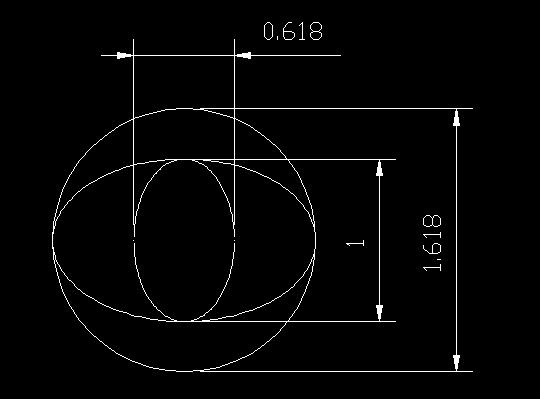Steel Hardness Golden Ratio
Dividing the circle area by bigger ellipse area, the areas includes the ratio of 1:1.618. The diameter of the circle per the ellipse minor axis length, includes the Golden Ratio. The larger elliptical area per the smaller elliptical area, has also the ratio 1.618.

When drawing an ellipse inside the ellipse having the ratio of 1.618, the area is 1:2.618 of the previous ellipse.
1 + 1.618 = 2.1618 1.618 x 1.618 = 2.618
Area of the circle is 2.0561 units
The larger ellipse has the area of 1.2708 units => 2.0561 / 1.2708 = 1.618
The smaller ellipse has the area of 0.4854 units => 1.2708 / 0.4854 = 2.618
The circular shape has the hardness of the material, strength ellipses.
Why to do this. This I'll expain through the strength calculation ...
The Golden Ratio joins to machine engineering most common material, steel. However, we do not notice the golden ratio, choosing the quality of steel, or examining the strength of steels. The tensile strength of steel is proportional to the hardness, in a such a way up to 100 kN/cm2, the ultimate tensile strength of carbon steel is 36% and alloy steel 34% of the Brinell hardness. The percentual share has been observed, but not the joining to the Golden Ratio.
The ratio φ (1.618). The ultimate tensile strength of carbon and low alloy steels, can be quite precisely determine by dividing the steel hardness HB by ratio 1.618. => HB 112 / 1.618 = 69.221 => σM = 112 - 69.221 = 42.8 kN/cm2. The value 42.8 kN/cm2 corresponds to S235 steel grade with a guaranteed ultimate tensile strength of at least 37 kN/cm2.
HB = Brinell hardness σM = The ultimate tensile strength
Structural steel S235 HB 100...125

9.1.2015*21:00 (977 - 337)
www.karikolehmainen.com
epcalculation@gmail.com |